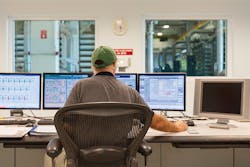Flowmeter verification for process-wide diagnostics
The biggest obstacle to increasing production and throughput is the testing and calibrating of Coriolis flowmeters — which measure mass, density and temperature — to ensure compliance at all times.
With a lack of moving parts and unobtrusive design, the Coriolis meter has demonstrated its value in delivering accurate measurements in various process conditions and fluid properties. Based on experience field data, the Coriolis meter has made testing, safety and regulatory adherence easier. Yet, there are still challenges.
The need for verification and calibration
Today, there is a demand for verification of Coriolis flowmeters, defined as correlating diagnostics to the primary variables to provide data on measurement performance and, if needed, calibration defined as comparing the true flow rate of the meter with the vibrational response of the meter.
When there are material or process issues, process engineers need to verify the flowmeters by removing them from the process loop and arranging for transport to a laboratory for review and possible recalibration.
Removing a meter from the process means process engineers may not have potentially critical data during operations, not to mention the significant cleaning, shipping and calibration costs, even if there is no need to adjust the flow calibration in the first place.
Importantly, even though substantial data exists to demonstrate the Coriolis flowmeter’s resistance to impacts from corrosion, erosion or overpressure, regular recalibration still occurs, which adds no value to the meter.
The challenges of meeting regulatory, maintenance and testing requirements
Meeting guidelines set out by agencies such as the Food and Drug Administration (FDA), the American Petroleum Institute (API), the American Gas Association (AGA) and the Environmental Protection Agency (EPA), Coriolis flowmeters face an ever-growing list of requirements from safety standards, ISO 9001 compliance and correct regulatory reporting. Here, plants often choose the default position — to pull, clean and recalibrate the meters, even if they are working perfectly already.
The growth in data
With more Coriolis flowmeters in service, there is a growing amount of data available on not only measurements but also maintenance. The quality of that data is critical, as it is fed into analytical and decision-making models.
Even though today’s process facilities have many alerts and reactive diagnostics that provide the first step to pre-empting potential production interruptions, when it comes to real-time intelligence and proactive or even predictive diagnostics, flowmeters too often fall short, and it becomes difficult for process engineers to answer key questions such as:
- Even if the meter was recently calibrated, how can I be sure it is operating effectively?
- Am I meeting safety and compliance requirements?
- Is there a way to prove to third parties that the meter does not require calibration?
Where traditional, more reactive diagnostics provide a starting point for further analysis, it is only through proactive and predictive diagnostics that the Coriolis flowmeter can answer these questions, generate real-time decision-making intelligence and deliver greater operational certainty.
Examples of flowmeter verification
Rather than costly and time-consuming maintenance and laboratory testing, causing production interruptions and a loss of data, Emerson’s Smart Meter Verification provides Coriolis meter verification on-demand, helping detect measurement inaccuracies while the meters remain installed. Such verification takes place in minutes without affecting the process or meter outputs, giving measurement confidence and allowing for immediate remedial action, thereby reducing unplanned or scheduled downtime.
The following two examples of Smart Meter Verification relate to tube stiffness and coating.
Vibrating flow tubes are at the core of the Coriolis flowmeter principle of operation and its ability to measure mass directly through the creation of a rotating frame of reference. As a mass moves to or away from the center of rotation inside a rotating tube, the fluid generates inertial forces on the tube. These forces act on the tubes, causing a time delay between inlet and outlet, with the time delay between the two locations directly proportional to mass flow rate.
At this point, a vital element of calibration is tube stiffness, with each meter having a unique stiffness value and where the meter will likely require recalibration if a change of tube thickness takes place in the field.
Smart Meter Verification provides algorithms that can detect any changes in tube stiffness due to corrosion or erosion — achieved by first characterizing the frequency response function curve and then running the meter at five different frequencies to define the curve and its three main elements: mass, dampening and stiffness.
This can also be determined through a clear audit trail that meets regulatory standards. If a change in stiffness is identified from the original base level — measured and stored at the factory where it was originally calibrated — then recalibration will be required. It is important to identify stiffness changes, corrosive damage and unintentional exposure to harmful fluids before it becomes a safety issue.
A second example relates to coating, which represents a significant challenge to meter performance and accuracy. Often, maintenance managers and process engineers only become aware of it when density measurements are affected, when running clean-in-place (CIP) cycles or when the meters fail a proving.
With the proactive diagnostics of Smart Meter Verification, the first signs of coating are detected before a proving and before triggering hot oil or cleaning cycles. This can also take place immediately, rather than in additional process loops, such as distributed control systems.
Smart Meter Verification meets clear and transparent verification audit trails and has advanced visual analysis and reporting software that meets third-party regulatory agency compliance requirements and can be used in lieu of meter calibration, inspection or removal. A time-stamped verification report increasingly meets a number of international standards and is recognized by third-party agencies as a method to confirm instrument calibration, which extends recalibration or proving intervals.
Tackling process issues across the plant
Proactive and predictive diagnostics are also helpful in using flowmeter calculations across the plant. Smart Meter Verification includes a "flow range" diagnostic, which alerts the engineer when flow rates are not within a specified range, as well as multiphase diagnostics that can provide immediate alerts to process upsets, such as aeration or when low flow rates may be affecting measurements. Furthermore, due to multiphase fluids tending to decouple under vibrating conditions, the severity of entrained or wet gas can be calculated directly by monitoring how hard the meter is working to vibrate the tubes.
Results from these proactive and predictive diagnostics are significant process improvements across plant operations.
Another issue that can cause potential problems is improper meter sizing. In those cases, the flow range diagnostic enables the operator to react to fluctuating production rates and sizing issues in real-time.
Flowmeter verification applications
The following field examples highlight the benefits of Smart Meter Verification.
A fast-track rehabilitation project in Northern Iraq was started to rebuild a liquid petroleum gas (LPG) loading terminal that had suffered fire damage. The project urgently required rapid execution because 1,000 m3 of merchantable LPG, valued at $5.5 million, was lost to flare every day. Four truck-loading skids needed to be installed, and the customer came to Emerson to replace the positive displacement (PD) meters with Micro Motion Coriolis meters with Smart Meter Verification.
The danger to the PD meters’ accuracy included high volatility, the risk of vapor breakout and high thermal expansion, but the customer was able to measure the LPG in both volume units and mass units simultaneously with the Micro Motion meter. The meter’s advanced diagnostics and Smart Meter Verification also provided the operator with confidence in the ongoing health of the meter and overall accuracy of the loading process.
A U.S. example considers the dangers of inaccurate verification and involves a major international confectionary manufacturer. Chocolate rework — or in this case, caramel — comes with significant measurement challenges in processing lines, with the thick slurry often sitting in the piping system instead of recirculating, creating the danger of plugging in the meter tubing. For this reason, it is necessary to conduct regular calibration checks on all measurement sensors involved in processing and testing results compared to reference meters to confirm performance.
In this case, there were two competitor meters on-site with an in-built verification system that were, for unknown reasons, providing negative flow measurements while under positive flow conditions. However, when the in-built verification system was initiated, it passed the meters, resulting in a situation where the diagnostics and auditors were claiming that an obviously broken system was in fact working. This led to additional downtime and maintenance, as other areas of the process were examined to explain the anomaly.
A Micro Motion Coriolis flowmeter was then deployed on a similar rework slurry line in the same plant and faced the same plugging challenges and negative flow measurement. Here, Smart Meter Verification and its diagnostics immediately failed the sensors, which were then pulled, cleaned and reinstalled with minimal downtime. A formal report was generated for engineers, plant operators and auditors.
Once cleaned and reinstalled, the sensors and meter tested close to the reference meter, were passed by Smart Meter Verification and became fully operational and effective. This led to cost savings and process improvements compared to the process and maintenance impact of inaccurate verification.
Diagnostics as part of everyday performance
With the continued focus on increasing efficiencies and reducing costs, a flow measurement system that can deliver proactive and predictive diagnostics, real-time decision-making intelligence and operational certainty has never been more important.
Coriolis meters with Smart Meter Verification are starting to reach their full potential, ensuring proactive, process-wide diagnostics as a major part of everyday performance and meeting all regulatory, testing and safety requirements.
Tom O’Banion is the director of global chemical application innovation for Emerson Automation Solutions, Micro Motion Inc. He has 30 years of industrial application experience in a variety of roles, including greenhouse gas compliance, process and natural gas market development and technical sales management covering Canada, Taiwan and mainland China. O’Banion holds two patents and is listed on three recent disclosures. He received a bachelor’s degree in chemical engineering from the University of Colorado and an MBA in energy management from the University of Denver. Previous employers include Conoco Oil and MW Kellogg (now KBR).



